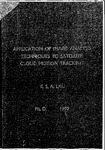APPLICATION OF IMAGE ANALYSIS TECHNIQUES TO SATELLITE CLOUD MOTION TRACKING
| dc.contributor.author | LAU, KING SHING ALBERT | |
| dc.contributor.other | School of Engineering, Computing and Mathematics | en_US |
| dc.date.accessioned | 2012-08-10T08:23:31Z | |
| dc.date.available | 2012-08-10T08:23:31Z | |
| dc.date.issued | 1992 | |
| dc.identifier | Not available | en_US |
| dc.identifier.uri | http://hdl.handle.net/10026.1/1131 | |
| dc.description.abstract |
Cloud motion wind (CMW) determination requires tracking of individual cloud targets. This is achieved by first clustering and then tracking each cloud cluster. Ideally, different cloud clusters correspond to diiferent pressure levels. Two new clustering techniques have been developed for the identification of cloud types in multi-spectral satellite imagery. The first technique is the Global-Local clustering algorithm. It is a cascade of a histogram clustering algorithm and a dynamic clustering algorithm. The histogram clustering algorithm divides the multi-spectral histogram into'non-overlapped regions, and these regions are used to initialise the dynamic clustering algorithm. The dynamic clustering algorithm assumes clusters have a Gaussian distributed probability density function with diiferent population size and variance. The second technique uses graph theory to exploit the spatial information which is often ignored in per-pixel clustering. The algorithm is in two stages: spatial clustering and spectral clustering. The first stage extracts homogeneous objects in the image using a family of algorithms based on stepwise optimization. This family of algorithms can be further divided into two approaches: Top-down and Bottom-up. The second stage groups similar segments into clusters using a statistical hypothesis test on their similarities. The clusters generated are less noisy along class boundaries and are in hierarchical order. A criterion based on mutual information is derived to monitor the spatial clustering process and to suggest an optimal number of segments. An automated cloud motion tracking program has been developed. Three images (each separated by 30 minutes) are used to track cloud motion and the middle image is clustered using Global-Local clustering prior to tracking. Compared with traditional methods based on raw images, it is found that separation of cloud types before cloud tracking can reduce the ambiguity due to multi-layers of cloud moving at different speeds and direction. Three matching techniques are used and their reliability compared. Target sizes ranging from 4 x 4 to 32 x 32 are tested and their errors compared. The optimum target size for first generation METEOSAT images has also been found. | en_US |
| dc.description.sponsorship | Meteorological Office, Bracknell | en_US |
| dc.language.iso | en | en_US |
| dc.publisher | University of Plymouth | en_US |
| dc.title | APPLICATION OF IMAGE ANALYSIS TECHNIQUES TO SATELLITE CLOUD MOTION TRACKING | en_US |
| dc.type | Thesis | |
| plymouth.version | Full version | en_US |
| dc.identifier.doi | http://dx.doi.org/10.24382/3676 | |
| dc.identifier.doi | http://dx.doi.org/10.24382/3676 |
Files in this item
This item appears in the following Collection(s)
-
01 Research Theses Main Collection
Research Theses Main


